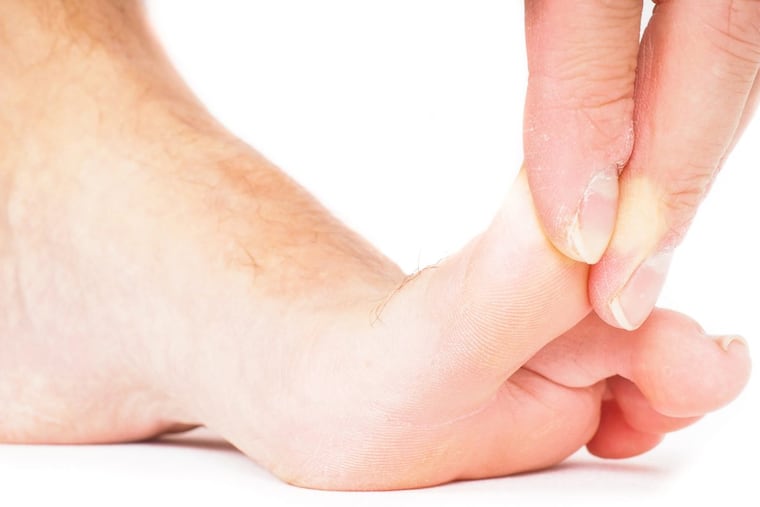What is toe jam? From harmless gunk to a feast for bugs
Toe jam can be a source of fascination, disgust or barely noticed. It can be a sign you need to wash your feet or rethink your choice of footwear. It can also lead to major health issues.

Q: What exactly is toe jam, anyway?
A: Toe jam can be a source of fascination or disgust, or barely noticed. It can be a sign that you need to wash your feet or rethink your choice of footwear. It can also lead to major health issues.
Toe jam isn’t a medical term. There is no formal medical term to describe the dead skin cells, sweat, sock lint, and dirt that combine in the small and often cramped spaces between our toes.
Toe jam can have the consistency of soft cheese or cake crumbs. It can smell or be odorless. And its color can range from white to gray-brown.
Poor foot hygiene will certainly make it more likely that you’ll develop toe jam. That’s because sweaty debris accumulates in between the toes if you don’t pay attention to cleaning these areas in the shower or bath.
Toe jam may also be more likely if your feet sweat a lot for other reasons. For instance, we know sweaty feet can be a problem for children and adolescents, who have more active sweat glands. And some people have a serious medical condition called hyperhidrosis, which has them sweating excessively.
Is toe jam like athlete’s foot?
The collection of sweat and dead skin between toes provides bacteria living naturally on our skin the chance to thrive.
This warm and damp environment is also a perfect site for tinea pedis, a fungal skin infection you might know as athlete’s foot.
Signs of tinea might be soggy white skin between your toes, which can be itchy, and red areas, a sign of skin damage. Damaged skin between toes might develop small fluid-filled blisters and may also bleed if the weak skin is torn.
So although toe jam isn’t the same as tinea, it might provide the perfect conditions for the fungus to grow.
How serious is toe jam?
Generally, toe jam is a minor health problem. You can manage it with good foot hygiene. And if you develop tinea, you can use a short course of an anti-fungal treatment you can buy from a pharmacy.
It is quite a different prospect, however, for a person living with a chronic disease such as diabetes, someone who has poor vision (and can’t see toe jam or its complications developing), or who may be unable to reach the feet due to limited mobility.
Diabetes not well-controlled with diet and exercise, or drugs, increases the risk of a person having reduced blood flow (peripheral arterial disease) and reduced feeling in the feet (sensory neuropathy).
Early identification of tinea in a vulnerable person is especially important to prevent complications.
4 ways to avoid problems
Wash the spaces between your toes and dry them carefully after a shower or bath, and after swimming. Gyms and swimming pools are a common place to pick up a fungal infection on your feet, so it’s a good idea to wear sandals to reduce the risk of tinea.
Avoid footwear that doesn’t allow sweat to evaporate.
Treat sweaty feet by using an anti-perspirant containing aluminium chloride. More severe cases of hyperhidrosis may be managed using drugs, such as Botox injections to the feet.
Pay attention to signs indicating that an infection is spreading from the foot, and see your health care provider immediately if you notice this.
Caroline Robinson is associate professor of podiatry and Luke Donnan is a lecturer in podiatry at Charles Sturt University in Australia. A version of this piece originally appeared on The Conversation.